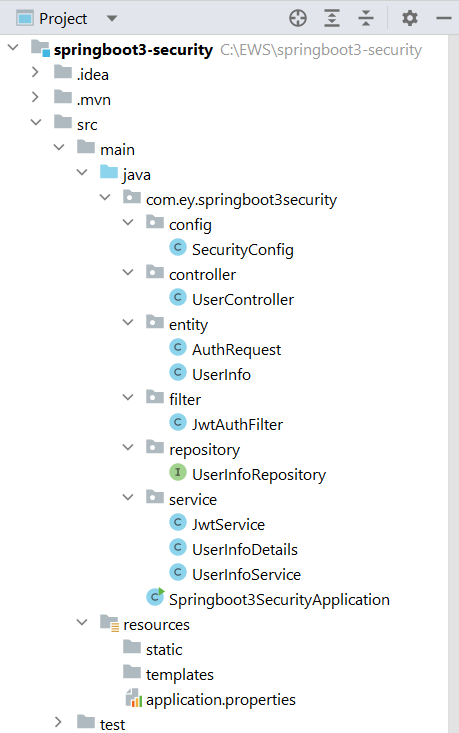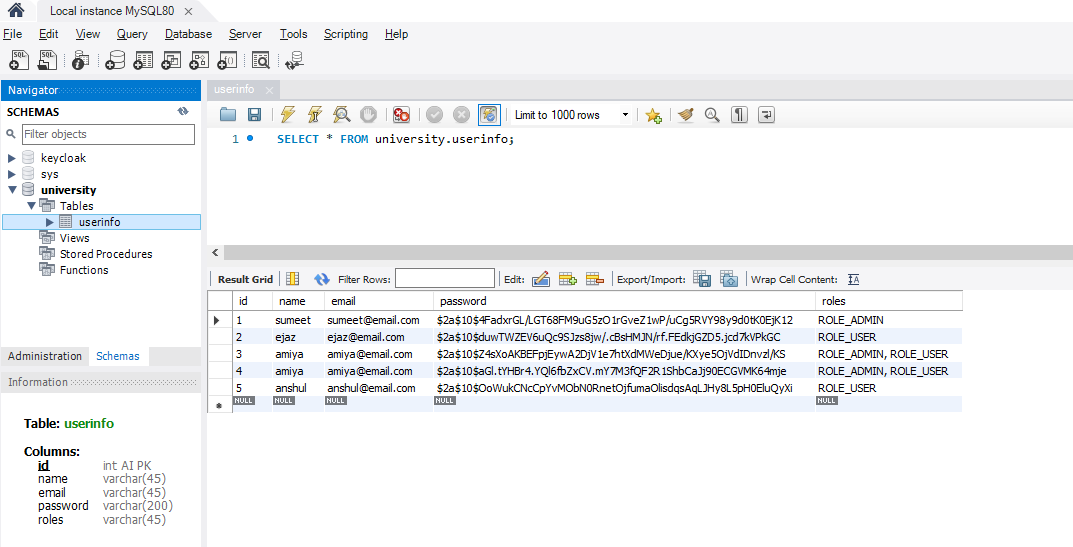Spring Boot 3.0 JWT Authentication with Spring Security using MySQL Database (original) (raw)
Last Updated : 05 May, 2025
In **Spring Security 5.7.0, the Spring team deprecated the **WebSecurityConfigurerAdapter, as they encourage users to move towards a component-based security configuration. Spring Boot 3.0 has come with many changes in Spring Security. In this article, we are going to learn how to implement **JWT authentication and authorization in a Spring Boot 3.0 application using Spring Security 6 with MySQL Database.
Demo Project
**Step 1: Create a New Spring Boot Project in Spring Initializr
To create a new Spring Boot project, please refer to How to Create a Spring Boot Project in Spring Initializr and Run it in IntelliJ IDEA . For this project, choose the following things:
- Project: Maven
- Language: Java
- Packaging: Jar
- Java: 17
Please choose the following dependencies while creating the project.
- Spring Web
- Spring Security
- MySQL Driver
- Spring Data JPA
- Lombok
Additionally, we have added dependencies for JWT also. Below are the dependencies
io.jsonwebtoken jjwt-api 0.11.5 io.jsonwebtoken jjwt-impl 0.11.5 io.jsonwebtoken jjwt-jackson 0.11.5
Below is the complete **pom.xml file. Please cross-verify if you have missed some dependencies.
XML `
4.0.0
<parent>
<groupId>org.springframework.boot</groupId>
<artifactId>spring-boot-starter-parent</artifactId>
<version>3.0.8</version>
<relativePath/> <!-- lookup parent from repository -->
</parent>
<groupId>com.gfg</groupId>
<artifactId>springboot3-security</artifactId>
<version>0.0.1-SNAPSHOT</version>
<name>springboot3-security</name>
<description>Demo project for Spring Boot 3 Security</description>
<properties>
<java.version>17</java.version>
<jjwt.version>0.11.5</jjwt.version>
</properties>
<dependencies>
<dependency>
<groupId>org.springframework.boot</groupId>
<artifactId>spring-boot-starter-data-jpa</artifactId>
</dependency>
<dependency>
<groupId>org.springframework.boot</groupId>
<artifactId>spring-boot-starter-security</artifactId>
</dependency>
<dependency>
<groupId>org.springframework.boot</groupId>
<artifactId>spring-boot-starter-web</artifactId>
</dependency>
<dependency>
<groupId>com.mysql</groupId>
<artifactId>mysql-connector-j</artifactId>
<scope>runtime</scope>
</dependency>
<dependency>
<groupId>org.projectlombok</groupId>
<artifactId>lombok</artifactId>
<optional>true</optional>
</dependency>
<dependency>
<groupId>org.springframework.boot</groupId>
<artifactId>spring-boot-starter-test</artifactId>
<scope>test</scope>
</dependency>
<dependency>
<groupId>org.springframework.security</groupId>
<artifactId>spring-security-test</artifactId>
<scope>test</scope>
</dependency>
<dependency>
<groupId>io.jsonwebtoken</groupId>
<artifactId>jjwt-api</artifactId>
<version>${jjwt.version}</version>
</dependency>
<dependency>
<groupId>io.jsonwebtoken</groupId>
<artifactId>jjwt-impl</artifactId>
<version>${jjwt.version}</version>
</dependency>
<dependency>
<groupId>io.jsonwebtoken</groupId>
<artifactId>jjwt-jackson</artifactId>
<version>${jjwt.version}</version>
</dependency>
</dependencies>
<build>
<plugins>
<plugin>
<groupId>org.springframework.boot</groupId>
<artifactId>spring-boot-maven-plugin</artifactId>
<version>3.0.8</version> <!-- Specify the version explicitly -->
<configuration>
<excludes>
<exclude>
<groupId>org.projectlombok</groupId>
<artifactId>lombok</artifactId>
</exclude>
</excludes>
</configuration>
</plugin>
</plugins>
</build>`
**Project Structure:
Before moving to the project here is the complete project structure.

**Step 2: Create a Controller
Go to the **src > main > java > controller and create a class **UserController and put the below code. In this, we have created a simple REST API in our controller class.
**UserController.java:
Java `
package com.ey.springboot3security.controller;
import com.ey.springboot3security.entity.AuthRequest; import com.ey.springboot3security.entity.UserInfo; import com.ey.springboot3security.service.JwtService; import com.ey.springboot3security.service.UserInfoService;
import org.springframework.beans.factory.annotation.Autowired; import org.springframework.security.access.prepost.PreAuthorize; import org.springframework.security.authentication.AuthenticationManager; import org.springframework.security.authentication.UsernamePasswordAuthenticationToken; import org.springframework.security.core.Authentication; import org.springframework.security.core.userdetails.UsernameNotFoundException;
import org.springframework.web.bind.annotation.*;
@RestController @RequestMapping("/auth") @RequiredArgsConstructor public class UserController {
private UserInfoService service;
private JwtService jwtService;
private AuthenticationManager authenticationManager;
@GetMapping("/welcome")
public String welcome() {
return "Welcome this endpoint is not secure";
}
@PostMapping("/addNewUser")
public String addNewUser(@RequestBody UserInfo userInfo) {
return service.addUser(userInfo);
}
// Removed the role checks here as they are already managed in SecurityConfig
@PostMapping("/generateToken")
public String authenticateAndGetToken(@RequestBody AuthRequest authRequest) {
Authentication authentication = authenticationManager.authenticate(
new UsernamePasswordAuthenticationToken(authRequest.getUsername(), authRequest.getPassword())
);
if (authentication.isAuthenticated()) {
return jwtService.generateToken(authRequest.getUsername());
} else {
throw new UsernameNotFoundException("Invalid user request!");
}
}}
`
**Step 3: Create a SecurityConfig Class
Go to the **src > main > java > config and create a class **SecurityConfig and put the below code. This is the new changes brought in Spring Boot 3.0.
Java `
package com.ey.springboot3security.config;
import com.ey.springboot3security.filter.JwtAuthFilter; import com.ey.springboot3security.service.UserInfoDetails;
import org.springframework.context.annotation.Bean; import org.springframework.context.annotation.Configuration; import org.springframework.security.authentication.AuthenticationManager; import org.springframework.security.authentication.AuthenticationProvider; import org.springframework.security.authentication.dao.DaoAuthenticationProvider; import org.springframework.security.config.annotation.authentication.builders.AuthenticationManagerBuilder; import org.springframework.security.config.annotation.authentication.configuration.AuthenticationConfiguration; import org.springframework.security.config.annotation.method.configuration.EnableMethodSecurity; import org.springframework.security.config.annotation.web.builders.HttpSecurity; import org.springframework.security.config.annotation.web.configuration.EnableWebSecurity; import org.springframework.security.config.http.SessionCreationPolicy; import org.springframework.security.core.userdetails.UserDetailsService; import org.springframework.security.crypto.bcrypt.BCryptPasswordEncoder; import org.springframework.security.crypto.password.PasswordEncoder; import org.springframework.security.web.SecurityFilterChain; import org.springframework.security.web.authentication.UsernamePasswordAuthenticationFilter;
@Configuration @EnableWebSecurity public class SecurityConfig {
private final JwtAuthFilter jwtAuthFilter;
private final UserDetailsService userDetailsService;
// Constructor injection for required dependencies
public SecurityConfig(JwtAuthFilter jwtAuthFilter,
UserDetailsService userDetailsService) {
this.jwtAuthFilter = jwtAuthFilter;
this.userDetailsService = userDetailsService;
}
/*
* Main security configuration
* Defines endpoint access rules and JWT filter setup
*/
@Bean
public SecurityFilterChain securityFilterChain(HttpSecurity http) throws Exception {
http
// Disable CSRF (not needed for stateless JWT)
.csrf(csrf -> csrf.disable())
// Configure endpoint authorization
.authorizeHttpRequests(auth -> auth
// Public endpoints
.requestMatchers("/auth/welcome", "/auth/addNewUser", "/auth/generateToken").permitAll()
// Role-based endpoints
.requestMatchers("/auth/user/**").hasAuthority("ROLE_USER")
.requestMatchers("/auth/admin/**").hasAuthority("ROLE_ADMIN")
// All other endpoints require authentication
.anyRequest().authenticated()
)
// Stateless session (required for JWT)
.sessionManagement(sess -> sess.sessionCreationPolicy(SessionCreationPolicy.STATELESS))
// Set custom authentication provider
.authenticationProvider(authenticationProvider())
// Add JWT filter before Spring Security's default filter
.addFilterBefore(jwtAuthFilter, UsernamePasswordAuthenticationFilter.class);
return http.build();
}
/*
* Password encoder bean (uses BCrypt hashing)
* Critical for secure password storage
*/
@Bean
public PasswordEncoder passwordEncoder() {
return new BCryptPasswordEncoder();
}
/*
* Authentication provider configuration
* Links UserDetailsService and PasswordEncoder
*/
@Bean
public AuthenticationProvider authenticationProvider() {
DaoAuthenticationProvider provider = new DaoAuthenticationProvider();
provider.setUserDetailsService(userDetailsService);
provider.setPasswordEncoder(passwordEncoder());
return provider;
}
/*
* Authentication manager bean
* Required for programmatic authentication (e.g., in /generateToken)
*/
@Bean
public AuthenticationManager authenticationManager(AuthenticationConfiguration config) throws Exception {
return config.getAuthenticationManager();
}}
`
**Step 4: Create Entity Classes
Go to the **src > main > java > entity and create a class **UserInfo and put the below code.
Java `
package com.ey.springboot3security.entity;
import jakarta.persistence.Entity; import jakarta.persistence.GeneratedValue; import jakarta.persistence.GenerationType; import jakarta.persistence.Id; import lombok.AllArgsConstructor; import lombok.Data; import lombok.NoArgsConstructor;
@Entity @Data @AllArgsConstructor @NoArgsConstructor public class UserInfo {
@Id
@GeneratedValue(strategy = GenerationType.IDENTITY)
private int id;
private String name;
private String email;
private String password;
private String roles;}
`
Similarly, create a class AuthRequest and put the below code.
Java `
package com.ey.springboot3security.entity;
import lombok.AllArgsConstructor; import lombok.Data; import lombok.NoArgsConstructor;
@Data @AllArgsConstructor @NoArgsConstructor public class AuthRequest {
private String username;
private String password;}
`
**Step 5: Create Filter Class
Go to the **src > main > java > filter and create a class **JwtAuthFilter and put the below code.
Java `
package com.ey.springboot3security.filter;
import com.ey.springboot3security.service.UserInfoDetails; import com.ey.springboot3security.service.JwtService;
import jakarta.servlet.FilterChain; import jakarta.servlet.ServletException; import jakarta.servlet.http.HttpServletRequest; import jakarta.servlet.http.HttpServletResponse; import org.springframework.beans.factory.annotation.Autowired; import org.springframework.security.authentication.UsernamePasswordAuthenticationToken; import org.springframework.security.core.context.SecurityContextHolder; import org.springframework.security.core.userdetails.UserDetails; import org.springframework.security.web.authentication.WebAuthenticationDetailsSource; import org.springframework.stereotype.Component; import org.springframework.web.filter.OncePerRequestFilter;
import java.io.IOException;
@Component public class JwtAuthFilter extends OncePerRequestFilter {
private final UserDetailsService userDetailsService;
private final JwtService jwtService;
@Autowired
public JwtAuthFilter(UserDetailsService userDetailsService, JwtService jwtService) {
this.userDetailsService = userDetailsService;
this.jwtService = jwtService;
}
@Override
protected void doFilterInternal(HttpServletRequest request, HttpServletResponse response, FilterChain filterChain) throws ServletException, IOException {
String authHeader = request.getHeader("Authorization");
String token = null;
String username = null;
if (authHeader != null && authHeader.startsWith("Bearer ")) {
token = authHeader.substring(7);
username = jwtService.extractUsername(token);
}
if (username != null && SecurityContextHolder.getContext().getAuthentication() == null) {
UserDetails userDetails = userDetailsService.loadUserByUsername(username);
if (jwtService.validateToken(token, userDetails)) {
UsernamePasswordAuthenticationToken authToken = new UsernamePasswordAuthenticationToken(
userDetails,
null,
userDetails.getAuthorities());
authToken.setDetails(new WebAuthenticationDetailsSource().buildDetails(request));
SecurityContextHolder.getContext().setAuthentication(authToken);
}
}
filterChain.doFilter(request, response);
}}
`
**Step 6: Create a Repository Interface
Go to the **src > main > java > repository and create an interface **UserInfoRepository and put the below code.
Java `
package com.ey.springboot3security.repository;
import com.ey.springboot3security.entity.UserInfo;
import org.springframework.data.jpa.repository.JpaRepository;
import java.util.Optional;
@Repository public interface UserInfoRepository extends JpaRepository<UserInfo, Integer> { Optional findByEmail(String email); // Use 'email' if that is the correct field for login }
`
**Step 7: Create Service Classes
Go to the **src > main > java > service and create a class **JwtService and put the below code.
Java `
package com.ey.springboot3security.service;
import io.jsonwebtoken.Claims; import io.jsonwebtoken.Jwts; import io.jsonwebtoken.SignatureAlgorithm; import io.jsonwebtoken.io.Decoders; import io.jsonwebtoken.security.Keys; import org.springframework.security.core.userdetails.UserDetails; import org.springframework.stereotype.Component;
import java.security.Key; import java.util.Date; import java.util.HashMap; import java.util.Map; import java.util.function.Function;
@Component public class JwtService {
public static final String SECRET = "5367566859703373367639792F423F452848284D6251655468576D5A71347437";
public String generateToken(String email) { // Use email as username
Map<String, Object> claims = new HashMap<>();
return createToken(claims, email);
}
private String createToken(Map<String, Object> claims, String email) {
return Jwts.builder()
.setClaims(claims)
.setSubject(email)
.setIssuedAt(new Date())
.setExpiration(new Date(System.currentTimeMillis() + 1000 * 60 * 30))
.signWith(getSignKey(), SignatureAlgorithm.HS256)
.compact();
}
private Key getSignKey() {
byte[] keyBytes = Decoders.BASE64.decode(SECRET);
return Keys.hmacShaKeyFor(keyBytes);
}
public String extractUsername(String token) {
return extractClaim(token, Claims::getSubject);
}
public Date extractExpiration(String token) {
return extractClaim(token, Claims::getExpiration);
}
public <T> T extractClaim(String token, Function<Claims, T> claimsResolver) {
final Claims claims = extractAllClaims(token);
return claimsResolver.apply(claims);
}
private Claims extractAllClaims(String token) {
return Jwts.parserBuilder()
.setSigningKey(getSignKey())
.build()
.parseClaimsJws(token)
.getBody();
}
private Boolean isTokenExpired(String token) {
return extractExpiration(token).before(new Date());
}
public Boolean validateToken(String token, UserDetails userDetails) {
final String username = extractUsername(token);
return (username.equals(userDetails.getUsername()) && !isTokenExpired(token));
}}
`
Similarly, create a class **UserInfoDetails and put the below code.
Java `
package com.ey.springboot3security.service;
import com.ey.springboot3security.entity.UserInfo;
import org.springframework.security.core.GrantedAuthority; import org.springframework.security.core.authority.SimpleGrantedAuthority; import org.springframework.security.core.userdetails.UserDetails;
import java.util.Collection; import java.util.List; import java.util.stream.Collectors;
public class UserInfoDetails implements UserDetails {
private String username; // Changed from 'name' to 'email' for clarity
private String password;
private List<GrantedAuthority> authorities;
public UserInfoDetails(UserInfo userInfo) {
this.username = userInfo.getEmail(); // Use email as username
this.password = userInfo.getPassword();
this.authorities = List.of(userInfo.getRoles().split(","))
.stream()
.map(SimpleGrantedAuthority::new)
.collect(Collectors.toList());
}
@Override
public Collection<? extends GrantedAuthority> getAuthorities() {
return authorities;
}
@Override
public String getUsername() {
return username;
}
@Override
public boolean isAccountNonExpired() {
return true;
}
@Override
public boolean isAccountNonLocked() {
return true;
}
@Override
public boolean isCredentialsNonExpired() {
return true;
}
@Override
public boolean isEnabled() {
return true;
}}
`
Similarly, create a class **UserInfoService and put the below code.
Java `
package com.ey.springboot3security.service;
import com.ey.springboot3security.entity.UserInfo; import com.ey.springboot3security.repository.UserInfoRepository;
import org.springframework.beans.factory.annotation.Autowired; import org.springframework.security.core.userdetails.UserDetails; import org.springframework.security.core.userdetails.UserDetailsService; import org.springframework.security.core.userdetails.UsernameNotFoundException; import org.springframework.security.crypto.password.PasswordEncoder; import org.springframework.stereotype.Service;
import java.util.Optional;
@Service public class UserInfoService implements UserDetailsService {
@Autowired
private UserInfoRepository repository;
@Autowired
private PasswordEncoder encoder;
@Override
public UserDetails loadUserByUsername(String username) throws UsernameNotFoundException {
Optional<UserInfo> userDetail = repository.findByEmail(username); // Assuming 'email' is used as username
// Converting UserInfo to UserDetails
return userDetail.map(UserInfoDetails::new)
.orElseThrow(() -> new UsernameNotFoundException("User not found: " + username));
}
public String addUser(UserInfo userInfo) {
// Encode password before saving the user
userInfo.setPassword(encoder.encode(userInfo.getPassword()));
repository.save(userInfo);
return "User Added Successfully";
}}
`
**Step 8: application.properties
Make the following changes in the **application.properties file:
spring.main.allow-circular-references=true
spring.datasource.driver-class-name=com.mysql.cj.jdbc.Driver
spring.datasource.url = jdbc:mysql://localhost:3306/university
spring.datasource.username = root
spring.datasource.password = 143@Arpilu
spring.jpa.hibernate.ddl-auto = update
spring.jpa.properties.hibernate.dialect = org.hibernate.dialect.MySQLDialect
spring.jpa.hibernate.naming.physical-strategy=org.hibernate.boot.model.naming.PhysicalNamingStrategyStandardImpl
Test the Application
Now run your application and test it out. Hit the following URL:
It will add the user to the database.

Below is our database screenshot.

Now, hit the following URL to generate the token.
It will generate the token.

Now using this take we can access our endpoint according to the ROLE. Hit the following URL and put the Bearer token.
Refer to the screenshot below.
